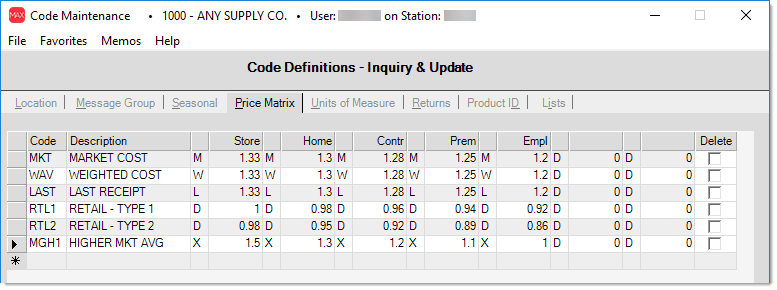Code Definitions > Price Matrix Codes
Price Matrix codes give you a way to calculate prices based upon a Cost or Suggested List Price amounts. You can use this form to add and modify existing matrices and delete unassigned matrix codes. You can remove Price Matrix codes individually from items in Item Maintenance. You should review and sometimes designate new pricing codes if you remove a matrix from an item (this depends on whether or not the item was initially added with a matrix or if at some point regular level pricing was used). In addition, changes to an existing matrix code from this area will not immediately update the pricing for items assigned to that code. Items must either be re-saved individually or updated using the Price Updates transaction (choose Price/Cost Entry, and use the Import (F2) function for Price Matrix) in the Inventory area to recalculate pricing.

Matrix-based pricing is different from the level pricing because instead of percentages, you use multipliers. For example, choosing a type of "D" within a matrix does not calculate using a discount percentage as it would when specifying price levels. Instead a "Multiplier of suggested list" is used. This means that if you enter 1.00 as the multiplier with type "D," that level will calculate a price that is the suggested list times 1 (in this case, the price level would equal the Suggested List Price).
An important point regarding matrix codes is that although the Type drop down lists both Markup and Margin Codes, either type functions exactly the same with regard to a matrix. There is no difference in the calculation when choosing a code normally used for margin or markup cost-based pricing. Specifically if you use the same multiplier to different levels for both types M and C (Market Cost), L and R (Last Receipt Cost), or W and A (Weighted Average), the application will calculate the same price will be calculated. Again, it doesn't matter whether you choose the markup or margin code for a specific cost type.*
*The additional types are included because they are part of a shared component.
When defining price matrices, it's important to keep in mind that multipliers are applied differently when using cost-based pricing vs. suggested list prices. Typically, a cost-based price is going to use a multiplier that is higher than 1.00 (a multiplier of 1.25 is effectively a 25% markup over cost). Multipliers for Suggested List Pricing are typically going to be either the same as the list price or lower, so a multiplier of 1.00 or lower would be used (a multiplier of .97 is the same as a 3% discount off the List Price).